Assessment of Energy Production Potential from Tidal Stream Currents in Morocco
Abstract
:1. Introduction
2. Data and Methods
2.1. Study Area and Available Tidal Data
2.2. Resource Assessment Methodology
3. Results and Discussion
3.1. Available Energy Potential
- For the year 2010, it has been found that the minimum values of the intensity of the current are almost zero and the maximum values are between 0.669–1.196 m/s. This last value observed in May and at the latitude: 36.000° and the longitude: −5.250°. Average current intensities vary between 0.235 m/s (±0.054) in August and 0.316 m/s (±0.089) in the month of January.
- For the year 2011, it has been noted that the minimum intensities are almost zero and maximum intensities vary between 0.718–1.061 m/s. the maximum values are observed in December at latitude: 36.000° and longitude: −5.333°.
- For the year 2012, it has been observed that the minimum values are very low and the maximum intensities are between (0.739–1.178) m/s. The maximum value is observed in April at the latitude: 36.000° and the longitude: −5.333°.
- For the year 2013, the minimum values of the intensity of the current are almost zero and the maximum values are between 0.610–1.256 m/s. The value 1.256 m/s are observed in March at latitude: 36.000° and longitude: −5.333°.
- For the year 2014, it has been noted that the minimum intensities are almost zero and the maximum values are between 0.818–1.194 m/s. The value 1.194 m/s is located in September at latitude: 36.000° and longitude: −5.333°.
- For the year 2010, it has been found the minimum values of the intensity of the current are almost zero and the maximum values are between 0.217 m/s and 0.395 m/s. This last value is of May and observed at the latitude: 21.004° and the longitude: −17.245°. Average current intensities vary between 0.067 m/s (±0.010) in July and 0.097 m/s (±0.017) in May.
- For the year 2011, it has been noted that the minimum intensities are almost zero. The highest peak intensities vary between (0.162–0.296) m/s. The maximum value is 0.296 m/s, taken in November at the latitude: 25.757° and the longitude: −16.495°. The average current values are recorded between 0.004 m/s (±0.018) in December and 0.107 m/s (±0.016) in November.
- For the year 2012, it has been found that the minimum values are very low and the maximum intensities are between 0.211 m/s and 0.383 m/s. This last value is observed in December at latitude: 21.004° and longitude: −17.245°. However, average current intensities varied between 0.066 m/s (±0.012) in January and 0.097 m/s (±0.023) in November.
- For the year 2013, the minimum values of the intensity of the current are almost zero and the maximum values are between (0.019–0.445) m/s. The value 0.445 m/s are observed in the month of February at the latitude: 21.004° and the longitude: 17.245. The average intensities range from 0.063 m/s (±0.011) in March to 0.087 m/s (±0.016) for the month of August.
- For the year 2014, it has been noticed that the minimum intensities are almost zero while the high maximum intensities take values between (0.212–0.395) m/s. The value 0.395 m/s are located in January at the latitude: 26.004° and the longitude: −18.495. The average intensities range from 0.073 m/s (±0.013) observed in February to 0.090 m/s (±0.015) in December.
- For the year 2010, it has been found that the minimum values of the intensity of the current are almost zero and the maximum values of the high intensities are between 0.290 m/s and 0.544 m/s. The last value is observed in May at the latitude: 24.416° and the longitude: −14.500°. Average current intensities vary between 0.015 m/s (±0.015) in January and 0.118 m/s (±0.017) in July.
- For the year 2011, it has been observed that the minimum intensities are almost zero whereas the maximum intensities vary between (0.281–0.679) m/s. The upper value of the maximums is located in October at latitude: 26.166° and longitude: −14.500°. The values regarding the average current are recorded between 0.061 m/s (±0.013) in January and 0.1209 m/s (±0.017) in August.
- For the year 2012, it was found that that the minimum values are very low and the higher intensities are between 0.319 m/s and 0.698 m/s. The last value observed was of May and was at the latitude: 26.416° and the longitude: −14.416°. Regarding average current intensities, they vary between 0.074 m/s (±0.015) in November and 0.126 m/s (±0.019) in August.
- For the year 2013, the minimum values of the intensity of the current are almost zero and the maximum values of these intensities take values between (0.266–0.681) m/s. The value 0.681 m/s are observed in the month of October at the latitude: 26.416° and the longitude: −14.416. The average intensities range from 0.063 m/s (±0.011) in March to 0.087 m/s (±0.016) for the month of August.
- For the year 2014, it has been noticed that the minimum intensities are almost zero while the high maximum intensities take values between (0.281–0.645) m/s. The value 0.645 m/s is located in August at the latitude: 26.416° and the longitude: −14.416°. The average intensities range from 0.072 m/s (±0.009) observed in December to 0.135 m/s (±0.025) in August.
3.2. Mean Annual Electrical Power
4. Conclusions
Author Contributions
Conflicts of Interest
Abbreviations-Acronyms
| HAMCT | Horizontal Axis Marine Current Turbine |
| GW | Gigawatt |
| MW | Megawatt |
| R&D | Research and Development |
| TW | Terawatt |
| CMEMS | Copernicus Marine Environment Monitoring Service |
| MAD | Moroccan dirham |
| kWh | Kilowatt-hour |
| UK | United Kingdom |
| MSL | Mean Sea Level |
References
- Mourad, N.; Mostapha, T.; Dennoun, S. Promotion of Renewable Marines Energies in Morocco: Perspectives and Strategies. World Acad. Sci. Eng. Technol. Int. J. Energy Power Eng. 2018, 12. [Google Scholar] [CrossRef]
- Aroussy, Y.; Nachtane, M.; Saifaoui, D.; Tarfaoui, M. Numerical investigation of a reverse osmosis desalination system with cogeneration and renewable energy integration. Int. J. Sci. Eng. Res. 2016, 7, 129–133. [Google Scholar]
- Legrand, C. Assessment of Tidal Energy Resource: Marine Renewable Energy Guides; European Marine Energy Centre: Orkney, UK, 2009. [Google Scholar]
- Charlier, R.H. A “sleeper” awakes: Tidal current power. Renew. Sustain. Energy Rev. 2003, 7, 515–529. [Google Scholar] [CrossRef]
- Do-Seong, B.; Hart, D.E.; Jeong, W.-J. Tidal current energy resources off the South and West coasts of Korea: Preliminary observation-derived estimates. Energies 2013, 6, 566–578. [Google Scholar]
- Sierra, J.P.; Martín, C.; Mösso, C.; Mestres, M.; Jebbad, R. Wave energy potential along the Atlantic coast of Morocco. Renew. Energy 2016, 96, 20–32. [Google Scholar] [CrossRef]
- Sutherland, G.; Foreman, M.; Garrett, C. Tidal current energy assessment for Johnstone strait, Vancouver island. Proc. Inst. Mech. Eng. Part A J. Power Energy 2007, 221, 147–157. [Google Scholar] [CrossRef]
- Nachtane, M.; Tarfaoui, M.; El Moumen, A.; Saifaoui, D. Numerical investigation of damage progressive in composite tidal turbine for renewable marine energy. In Proceedings of the 2016 International Renewable and Sustainable Energy Conference (IRSEC), Marrakech, Morocco, 14–17 November 2016; pp. 559–563. [Google Scholar]
- Ng, K.W.; Lam, W.H.; Ng, K.C. 2002–2012: 10 years of research progress in horizontal-axis marine current turbines. Energies 2013, 6, 1497–1526. [Google Scholar] [CrossRef]
- Soukissian, T.H.; Denaxa, D.; Karathanasi, F.; Prospathopoulos, A.; Sarantakos, K.; Iona, A.; Georgantas, K.; Mavrakos, S. Marine Renewable Energy in the Mediterranean Sea: Status and Perspectives. Energies 2017, 10, 1512. [Google Scholar] [CrossRef]
- Soukissian, T.; Karathanasi, F.; Axaopoulos, P. Satellite-based offshore wind resource assessment in the Mediterranean Sea. IEEE J. Ocean. Eng. 2017, 42, 73–86. [Google Scholar] [CrossRef]
- Tarfaoui, M.; Nachtane, M.; Khadimallah, H.; Saifaoui, D. Simulation of Mechanical Behavior and Damage of a Large Composite Wind Turbine Blade under Critical Loads. Appl. Compos. Mater. 2017, 1–18. [Google Scholar] [CrossRef]
- Nachtane, M.; Tarfaoui, M.; Saifaoui, D.; El Moumen, A.; Hassoon, O.H.; Benyahia, H. Evaluation of durability of composite materials applied to renewable marine energy: Case of ducted tidal turbine. Energy Rep. 2018, 4, 31–40. [Google Scholar] [CrossRef]
- El-Katiri, L. Les Atouts du Maroc dans le Domaine de l’Energie Verte/Morocco’s Green Energy Opportunity; OCP Policy Centre: Rabat, Morocco, 2016. [Google Scholar]
- Amry, Y.; El Gaidi, M.; Nachtane, M. Design and optimization of a smart meter to meet the growing needs of energy in Morocco. In Proceedings of the 2016 International Renewable and Sustainable Energy Conference (IRSEC), Marrakech, Morocco, 14–17 November 2016; pp. 1115–1118. [Google Scholar]
- Manasseh, R.; Sannasiraj, S.A.; McInnes, K.L.; Sundar, V.; Jalihal, P. Integration of wave energy and other marine renewable energy sources with the needs of coastal societies. Int. J. Ocean Clim. Syst. 2017, 8, 19–36. [Google Scholar] [CrossRef]
- Hassoon, O.H.; Tarfaoui, M.; El Moumen, A.; Benyahia, H.; Nachtane, M. Numerical Evaluation of Dynamic Response for Flexible Composite Structures under Slamming Impact for Naval Applications. Appl. Compos. Mater. 2017, 1–18. [Google Scholar] [CrossRef]
- Amegroud, T. Morocco’s Power Sector Transition: Achievements and Potential; Istituto Affari Internazionali: Roma, Italy, 2015. [Google Scholar]
- Sotillo, M.G.; Lorente, P.; Levier, B.; Drevillon, M.; Chanut, J.; Amo Baladrón, A. Quality Information Document for Atlantic—Iberian Biscay Irish—Ocean Physics Analysis and Forecasting Product. Available online: http://marine.copernicus.eu/services-portfolio/access-to-products/ (accessed on 30 November 2017).
- Lecornu, F.; Pineau-Guillou, L.; Dumas, F.; Le Traon, P.Y.; Gohin, F.; Menesguen, A. PREVIMER: A coastal operational oceanography system coupled to the Copernicus Marine Service. In Proceedings of the GODAE OceanView Symposium 2013 5 years of GODAE OceanView—Current Progress and Future Priorities, Baltimore, MD, USA, 4–6 November 2013. [Google Scholar]
- Rusu, E. Evaluation of the wave energy conversion efficiency in various coastal environments. Energies 2014, 7, 4002–4018. [Google Scholar] [CrossRef]
- NOVELTIS’Global Marine Tidal Currents. Available online: http://tips.noveltis.com/ (accessed on 30 November 2017).
- Nachtane, M.; Tarfaoui, M.; Saifaoui, D. Matériaux Composites Pour les Energies Marines Renouvelables. Available online: https://www.editions-ue.com/ (accessed on 21 December 2017).
- Aroussy, Y.; Nachtane, M.; Saifaoui, D.; Tarfaoui, M.; Farah, Y.; Abid, M. Using renewable energy for seawater desalination and electricity production in the site ocp Morocco. J. Sci. Arts 2016, 16, 395–406. [Google Scholar]
- Nachtane, M.; Tarfaoui, M.; El Moumen, A.; Saifaoui, D. Damage prediction of horizontal axis marine current turbines under hydrodynamic, hydrostatic and impacts loads. Compos. Struct. 2017, 170, 146–157. [Google Scholar] [CrossRef]
- Blunden, L.S. New Approach to Tidal Stream Energy Analysis at Sites in the English Channel. Ph.D. Thesis, University of Southampton, Southampton, UK, 2009. [Google Scholar]
- Chen, W.B.; Liu, W.C.; Hsu, M.H. Modeling evaluation of tidal stream energy and the impacts of energy extraction on hydrodynamics in the Taiwan Strait. Energies 2013, 6, 2191–2203. [Google Scholar] [CrossRef]
- Allouhi, A.; Zamzoum, O.; Islam, M.R.; Saidur, R.; Kousksou, T.; Jamil, A.; Derouich, A. Evaluation of wind energy potential in Morocco’s coastal regions. Renew. Sustain. Energy Rev. 2017, 72, 311–324. [Google Scholar] [CrossRef]
- Liberti, L.; Carillo, A.; Sannino, G. Wave energy resource assessment in the Mediterranean, the Italian perspective. Renew. Energy 2013, 50, 938–949. [Google Scholar] [CrossRef]
- Arena, F.; Laface, V.; Malara, G.; Romolo, A.; Viviano, A.; Fiamma, V.; Sannino, G.; Carillo, A. Wave climate analysis for the design of wave energy harvesters in the Mediterranean Sea. Renew. Energy 2015, 77, 125–141. [Google Scholar] [CrossRef]
- Hilmi, K.; Orbi, A.; Makaoui, A.; Bouksim, H.; Idrissi, M.; Ettahiri, O.; Benyounes, A.; Ait Chattou, M. Circulation marine de la baie de Dakhla (Sud du Maroc) par modèle hydrodynamique 2D. Eur. Sci. J. 2017, 13, 69–82. [Google Scholar]
- Jayed, M.; Benbrahim, S.; Bakkas, S.; Ramdani, M.; Flower, R. Accumulation of Organochlorines in the European Clam (Ruditapes decussatus) and Sediment of the Oualidia Lagoon (Morocco). Bull. Environ. Contam. Toxicol. 2015, 94, 614–621. [Google Scholar] [CrossRef] [PubMed]
- A l’Approche du Détroit de Gibraltar. Available online: http://sailing.morisseauconsulting.com/a-lapproche-du-detroit-de-gibraltar/ (accessed on 30 December 2017).
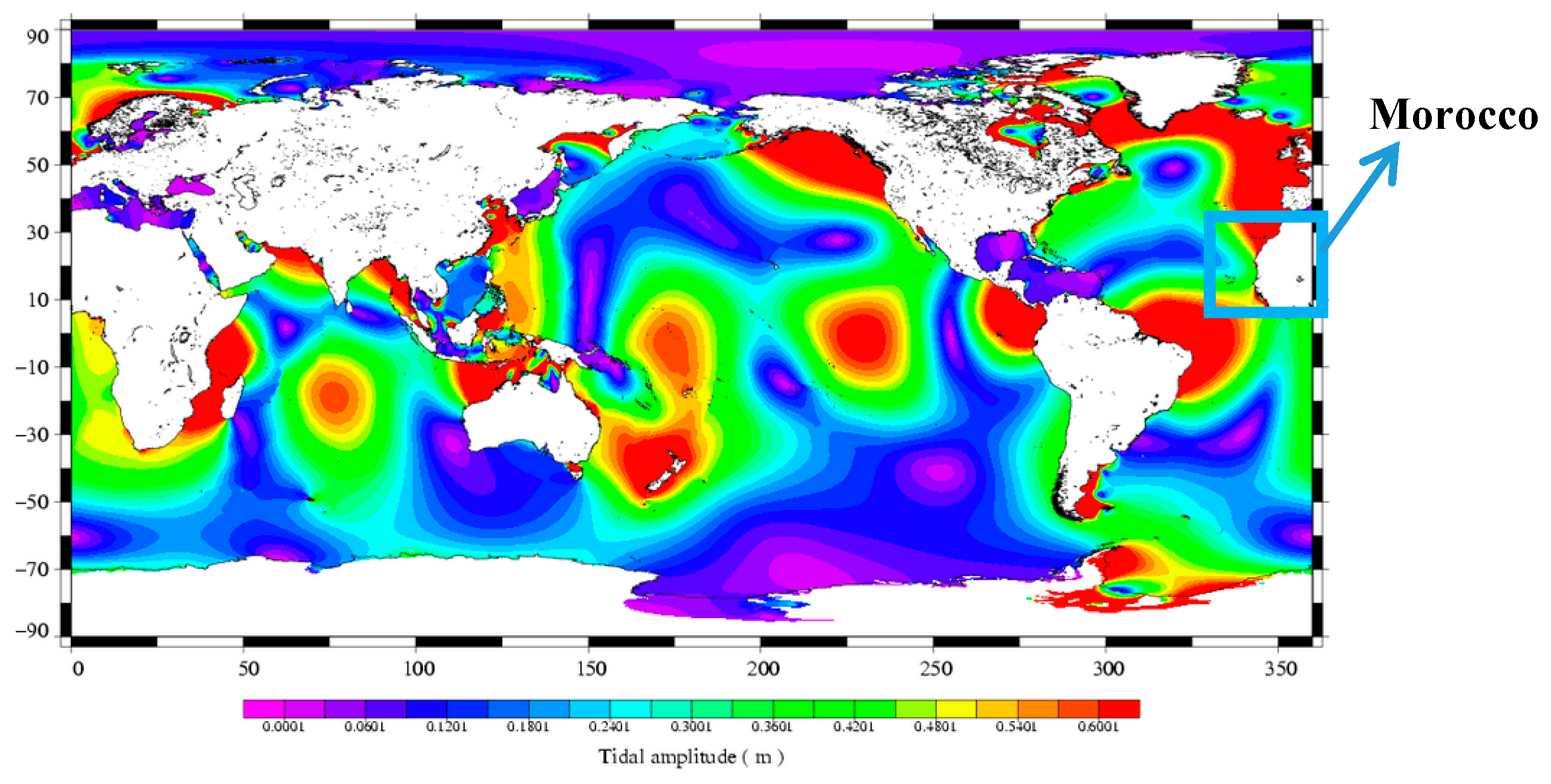
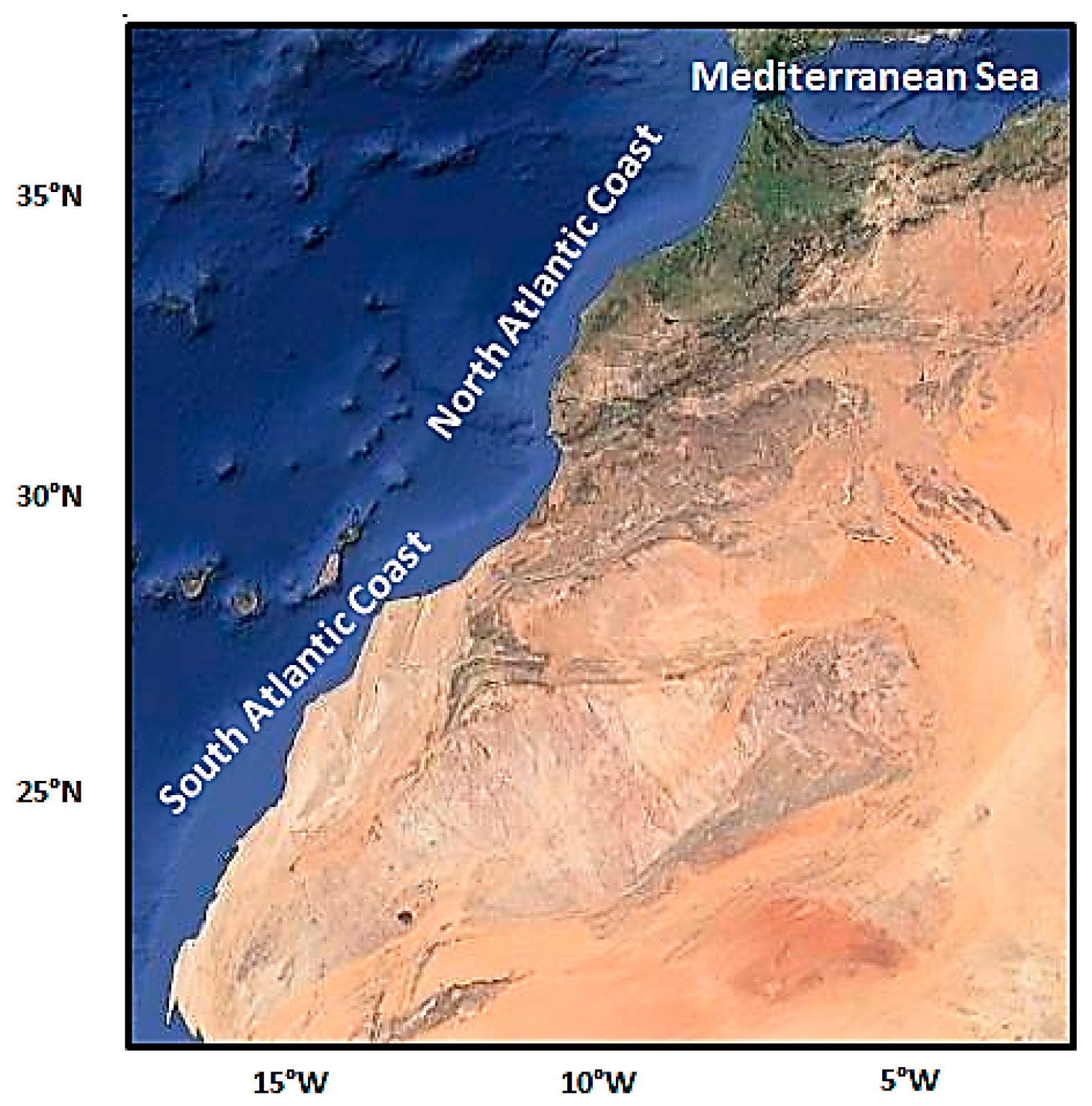
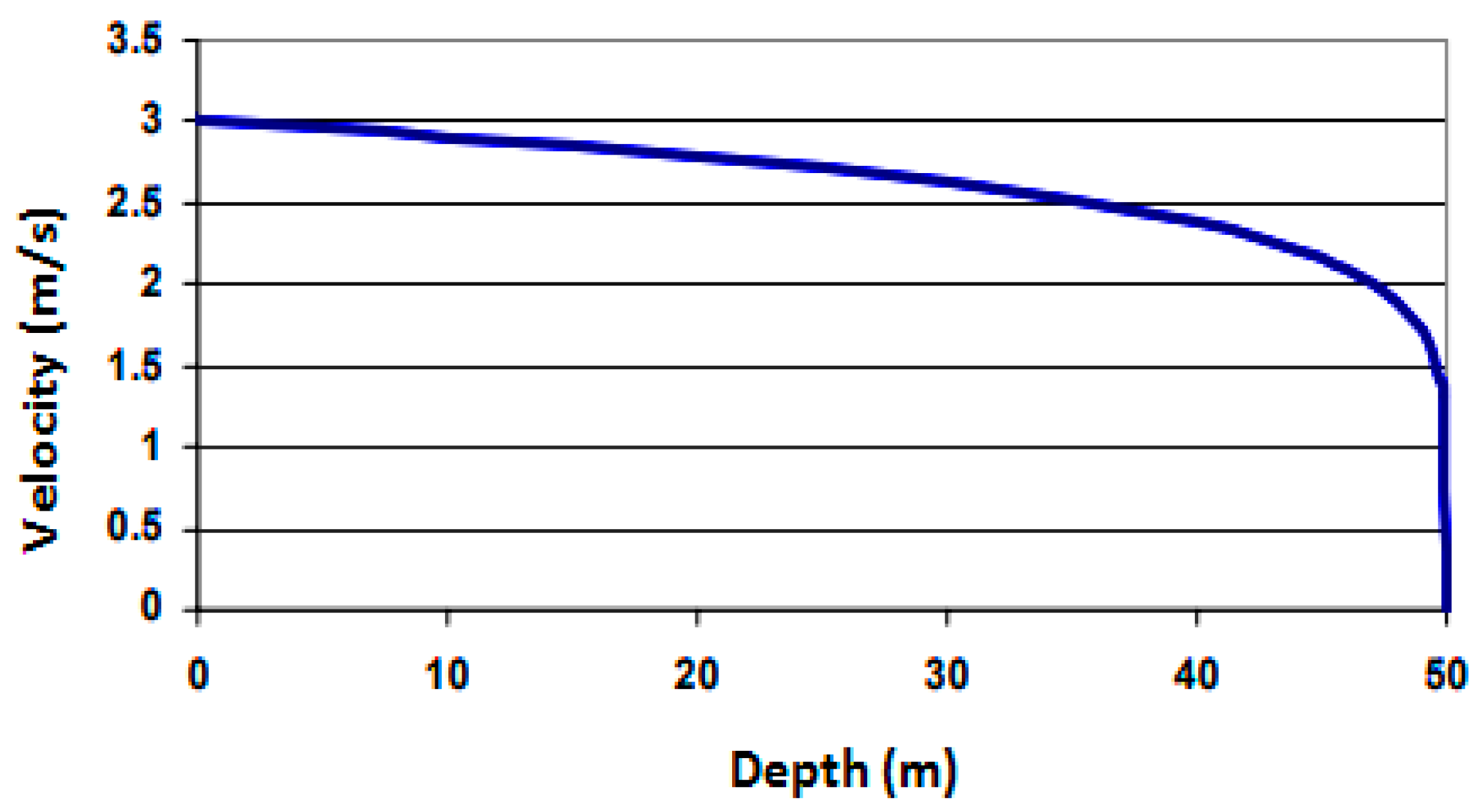

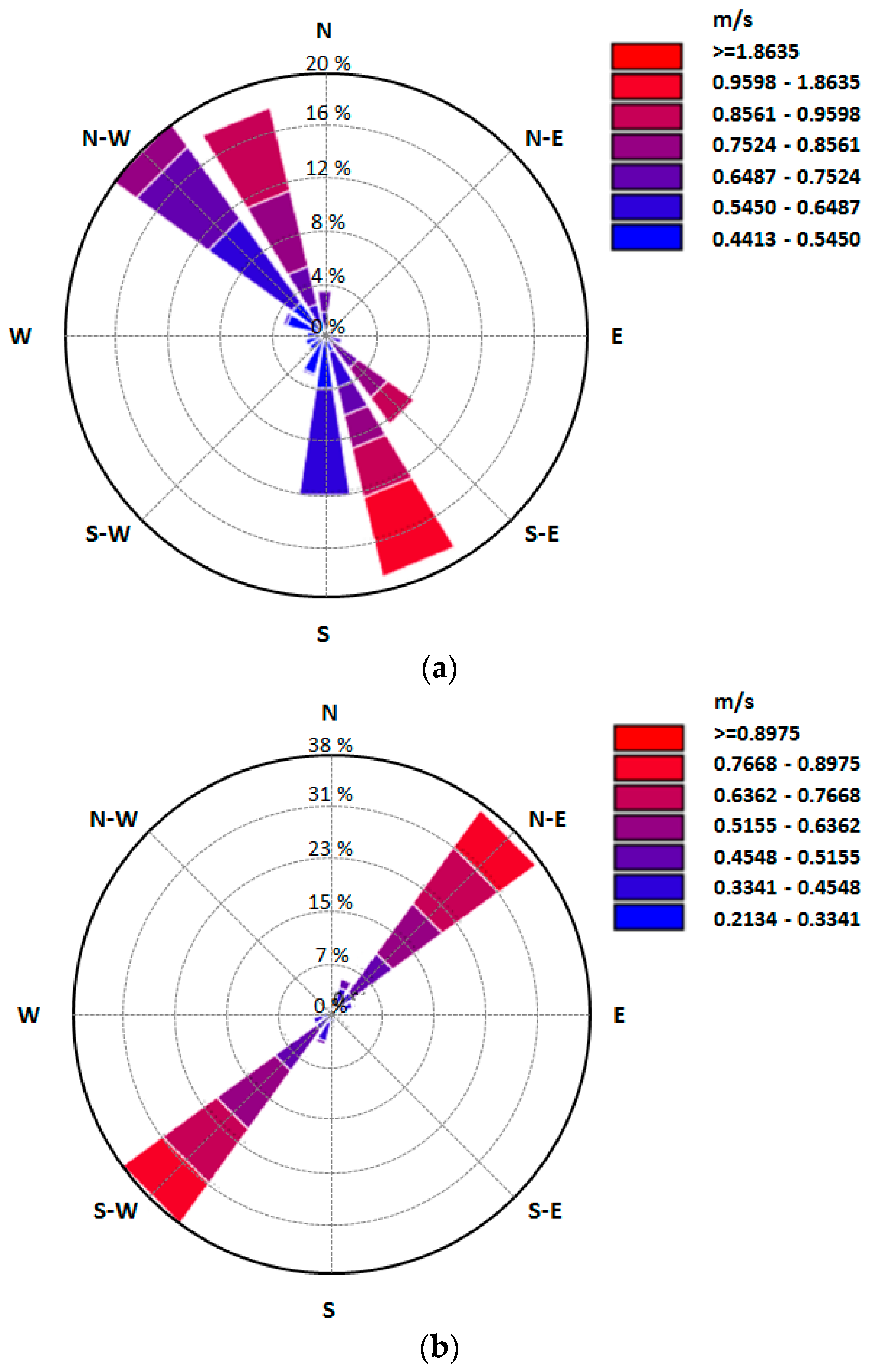

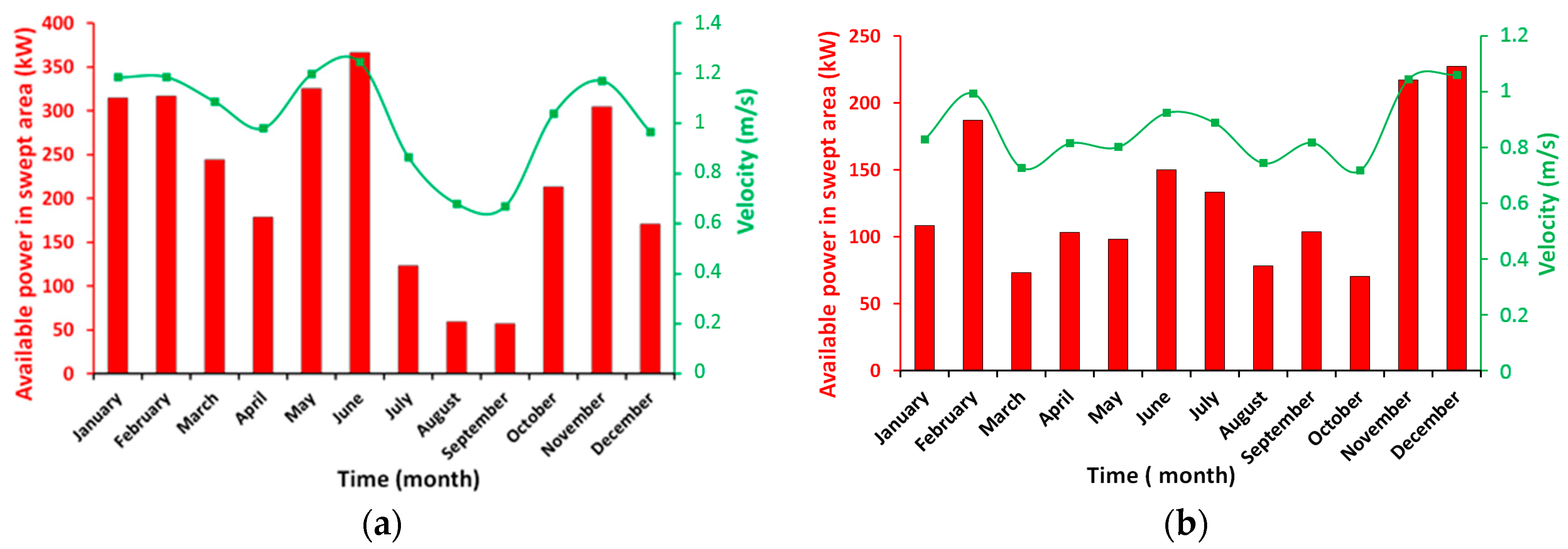
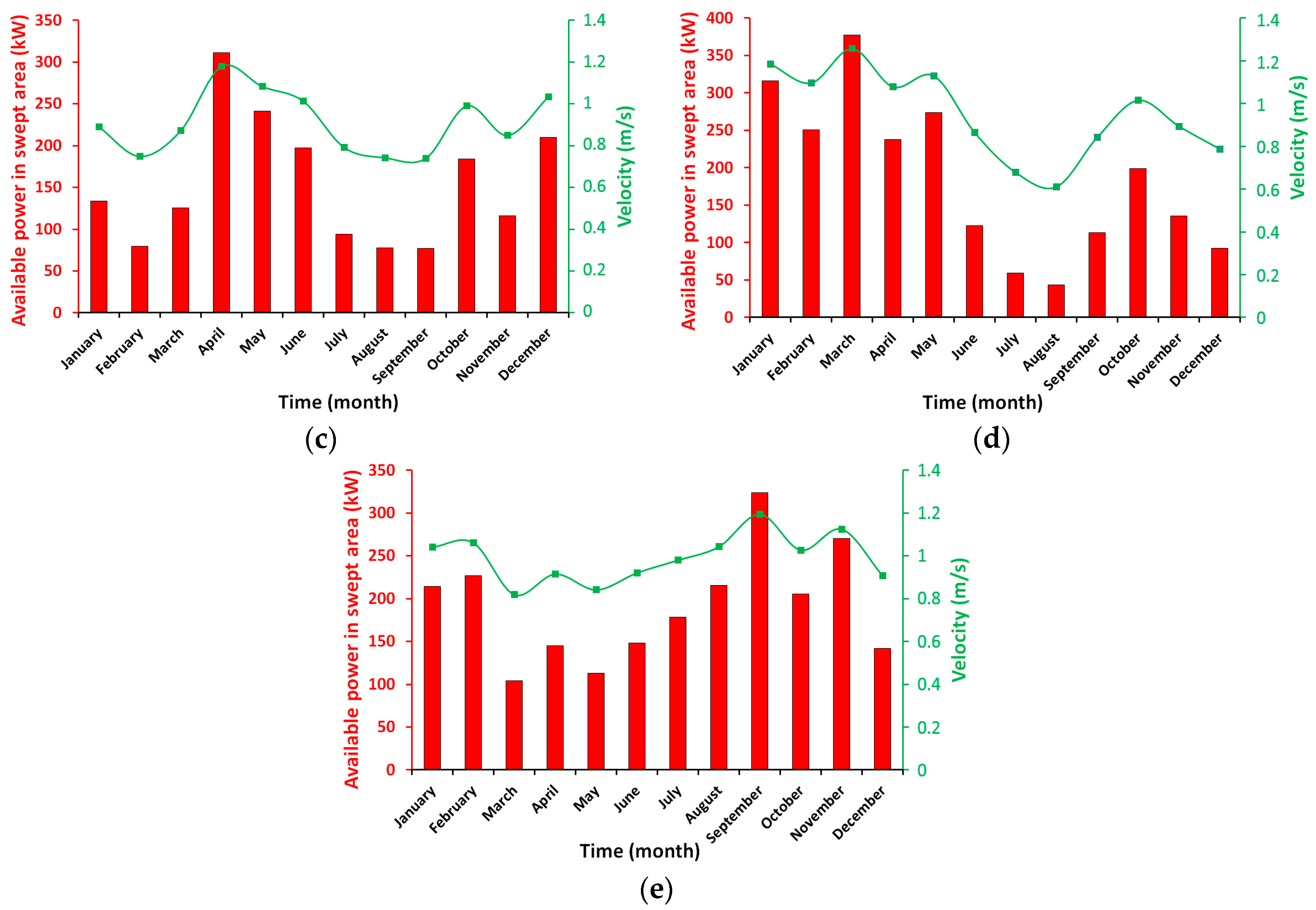

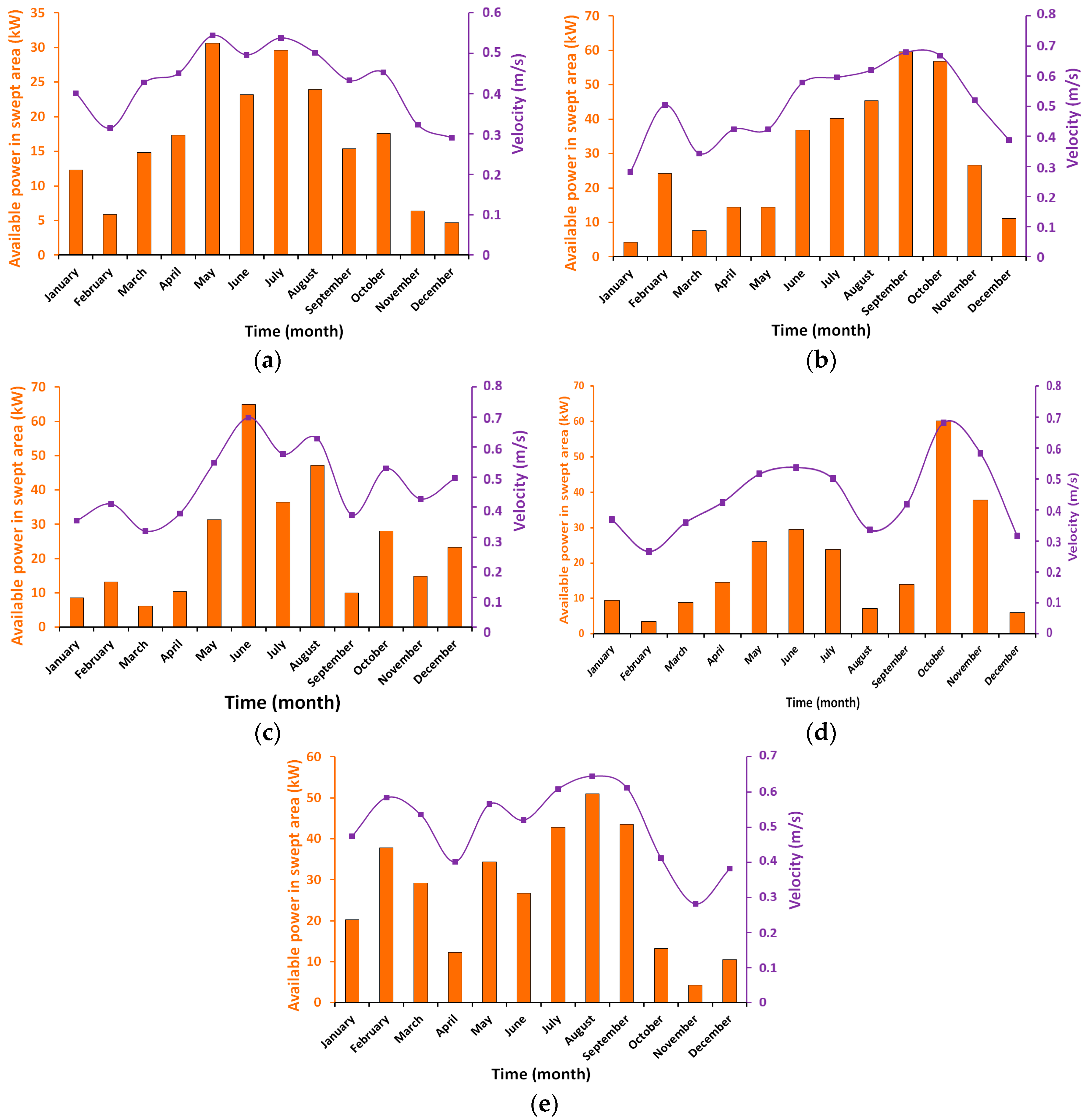

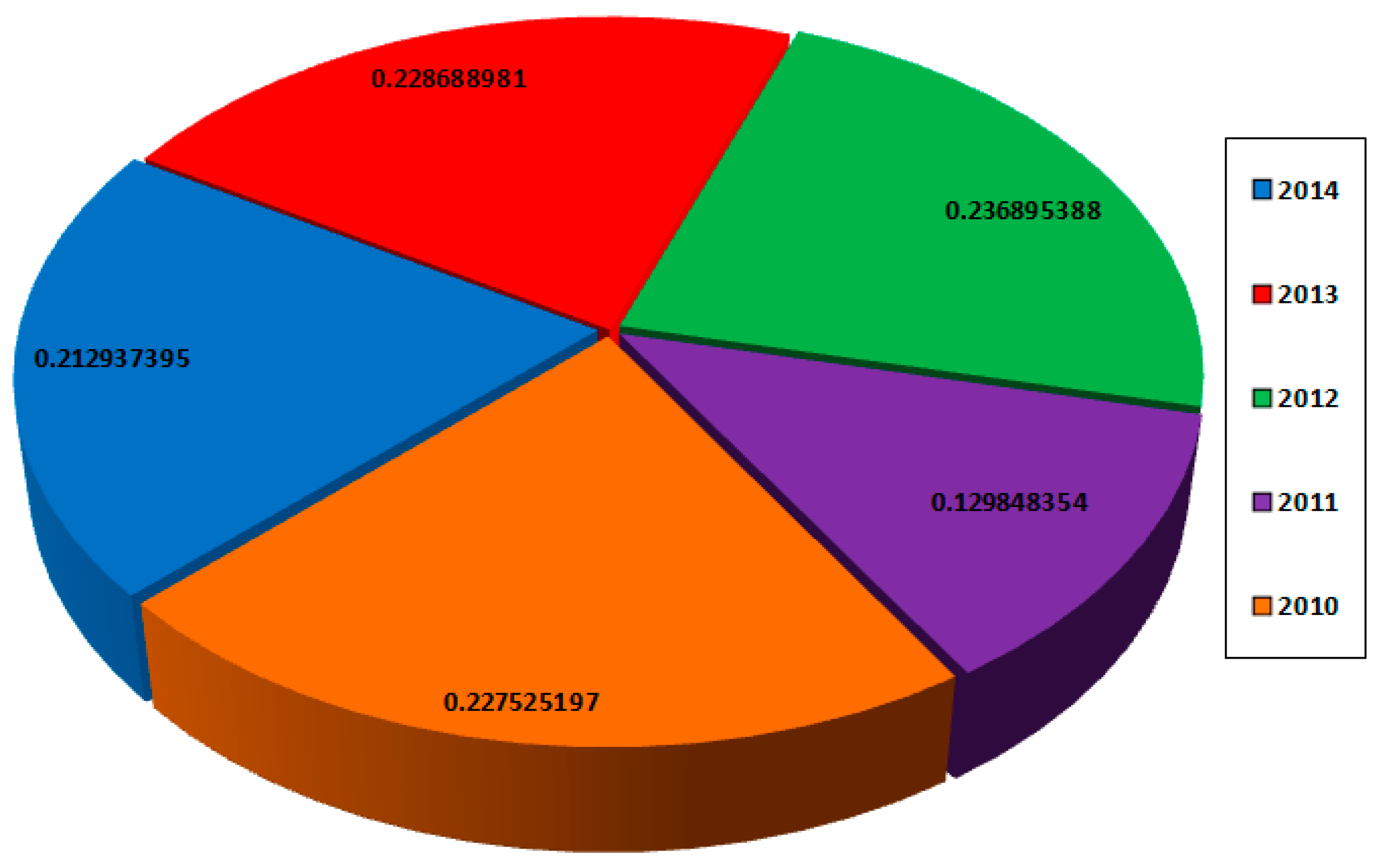
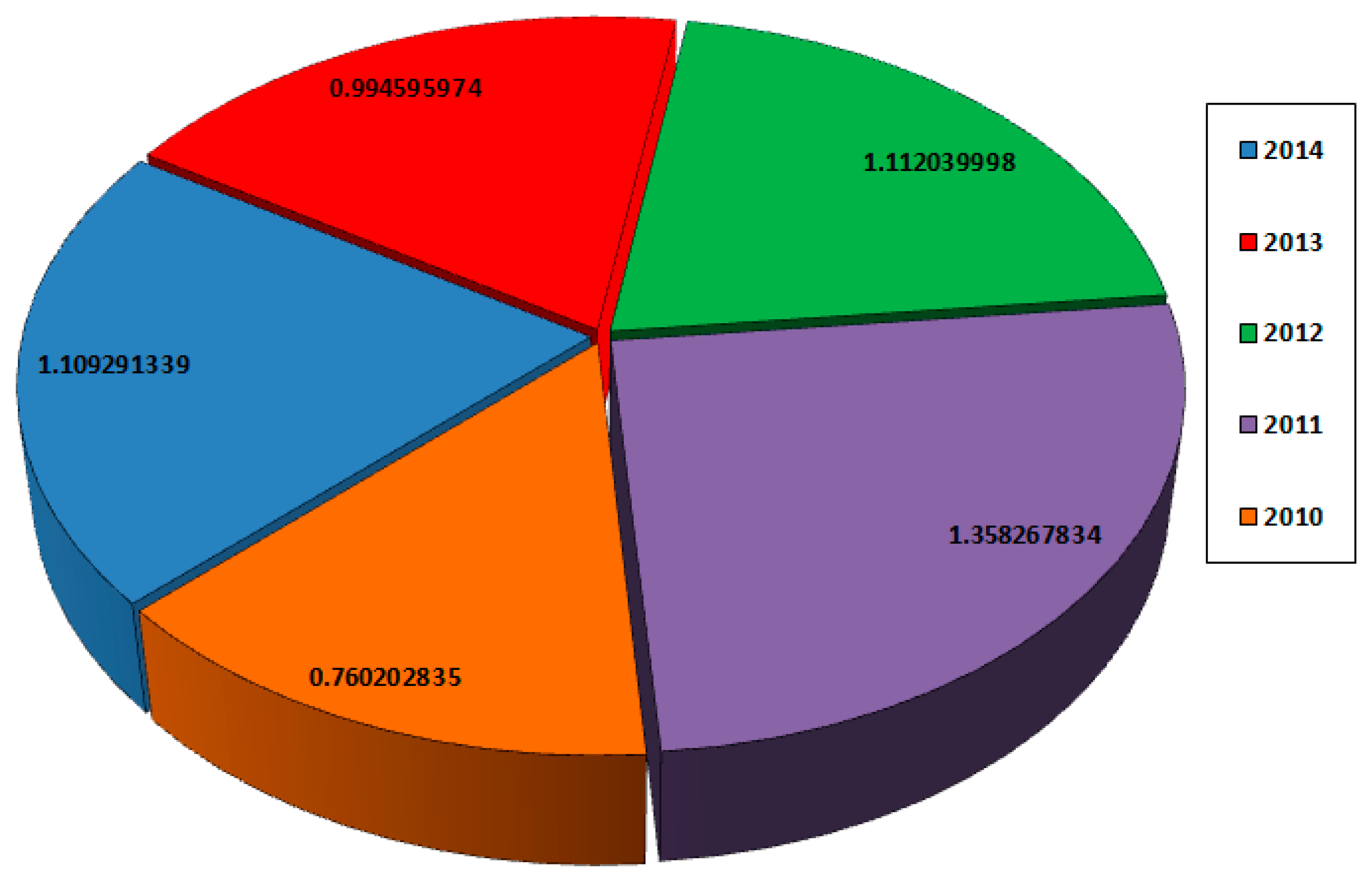
| Regions | Geographical Coordinates | Catalog |
|---|---|---|
| Mediterranean Sea | 6° W–2° W; 37° N 35° N | IBERIA-BISCAY-IRELAND REGIONAL SEAS (IBI) |
| South Atlantic Coast | 22° W–13° W; 26° N 21° N | GLOBAL_REP_PHY_001_021 |
| North Atlantic Coast | 19° W–5° W; 35° N 26° N | GLOBAL_REP_PHY_001_021 |
| Steps | Description |
|---|---|
| Step 1 | Selection of sites suitable for establishing arrays of tidal current generators. This is mainly restricted by a minimum value of mean cube flow velocity and an appropriate range of depths for a specific kind of generator. |
| Step 2 | Initial sizing and evaluating of the generating device to maximize energy captured from the life of the device taking into account elements such as the long-term variations in flow velocity; a vertical profile of flow velocity; deviation of the flow from rectilinear motion. |
| Step 3 | Given the device parameters above, the study of various arrangements (longitudinal spacing, lateral spacing, and orientation) of generators within the chosen site to maximize coupled power output. Revision of generator parameters if needed. |
| Step 4 | Survey of the extent of the significant impact of the proposed tidal current generator array on tidal parameters. If requisite, improvements made to power output evaluate due to resulting changes in boundary conditions. |
© 2018 by the authors. Licensee MDPI, Basel, Switzerland. This article is an open access article distributed under the terms and conditions of the Creative Commons Attribution (CC BY) license (http://creativecommons.org/licenses/by/4.0/).
Share and Cite
Nachtane, M.; Tarfaoui, M.; Hilmi, K.; Saifaoui, D.; El Moumen, A. Assessment of Energy Production Potential from Tidal Stream Currents in Morocco. Energies 2018, 11, 1065. https://doi.org/10.3390/en11051065
Nachtane M, Tarfaoui M, Hilmi K, Saifaoui D, El Moumen A. Assessment of Energy Production Potential from Tidal Stream Currents in Morocco. Energies. 2018; 11(5):1065. https://doi.org/10.3390/en11051065
Chicago/Turabian StyleNachtane, Mourad, Mostapha Tarfaoui, Karim Hilmi, Dennoun Saifaoui, and Ahmed El Moumen. 2018. "Assessment of Energy Production Potential from Tidal Stream Currents in Morocco" Energies 11, no. 5: 1065. https://doi.org/10.3390/en11051065






